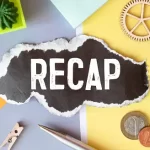Evolution of Recycling
Mike Hammer, Director of Recycling Operations
Waste Management
You could hear a pin drop in Jordan Hall at the Church of the Good Shepherd last Friday, when Mike Hammer, Director of Recycling Operations for Waste Management took to the podium to shed some light on the evolution of recycling. Rotarians were captivated by Mike’s enlightening presentation.
Mike explained how chemically, something can be recyclable but in order for it to be recycled, there needs to be a way to collect and process the recyclables so there is little if no contamination of food waste and most importantly an end market to buy the recyclable material. Those three factors coupled with new packaging and consumer behavior is reducing the amount of recyclables being disposed.
Laundry soap used to be in big plastic bottles and is now in a small pouch with pods of detergent, all of which is not recyclable. Tuna used to be in a tin can and now is available in a pouch. Also, what is recyclable like plastic water bottles are being made much more light weight, meaning it takes a whole lot more water bottles to make up a ton of recyclables. Since 2005, the weight of a plastic bottle has been reduced by 37%. It now takes 35,000 more water bottles to make up a ton. Also, with the internet, most newspapers on now being read online, greatly reducing the amount of newspaper in the recycle stream. So even though packaging size is reducing and becoming more lightweight, the cost to process these recyclables remains the same or increases. In many cases, it is cheaper to make the product from virgin materials than to make it from recycled materials.
Across the country, many states are adopted goals of how much material they want diverted from their landfills, with California setting a goal of 75% reduction by 2020. Today, we have reached diversion of the most common materials such as paper, cardboard, plastic, tin, aluminum and glass. The next step is to divert organic waste such as food and green waste which is more difficult and costly. American consumers, businesses, and farms spend $218 billion a year, or 1.8% of GDP growing, processing, transporting, and disposing of food that is never eaten. 52 Millions tons of food is sent to landfills annually – 21% of landfill volume.
If the diversion goals are not reached, the State will look to trying to divert much more complicated materials such as the small pouch packaging which is usually contaminated with food residue. Most recycling facilities in the United States today are not designed to handle this type of product. This is why we must all do our part to be diligent in recycling the most basic items: paper, cardboard, plastics of all sorts except plastic bags, metals and glass.

 Let’s Recap! 4/19/24
Let’s Recap! 4/19/24